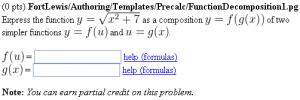Difference between revisions of "FunctionDecomposition1"
(add historical tag and give links to newer problems.) |
|||
| (7 intermediate revisions by 4 users not shown) | |||
| Line 1: | Line 1: | ||
| + | {{historical}} |
||
| + | |||
| + | <p style="font-size: 120%;font-weight:bold">This problem has been replaced with [https://openwebwork.github.io/pg-docs/sample-problems/Algebra/FunctionDecomposition.html a newer version of this problem]</p> |
||
| + | |||
| + | |||
<h2>Function Decomposition</h2> |
<h2>Function Decomposition</h2> |
||
[[File:FunctionDecomposition1.png|300px|thumb|right|Click to enlarge]] |
[[File:FunctionDecomposition1.png|300px|thumb|right|Click to enlarge]] |
||
| − | <p style="background-color:# |
+ | <p style="background-color:#f9f9f9;border:black solid 1px;padding:3px;"> |
This PG code shows how to check student answers that are a composition of functions. |
This PG code shows how to check student answers that are a composition of functions. |
||
</p> |
</p> |
||
| − | * Download file: [[File:FunctionDecomposition1.txt]] (change the file extension from txt to pg when you save it) |
||
| + | * File location in OPL: [https://github.com/openwebwork/webwork-open-problem-library/blob/master/OpenProblemLibrary/FortLewis/Authoring/Templates/Precalc/FunctionDecomposition1.pg FortLewis/Authoring/Templates/Precalc/FunctionDecomposition1.pg] |
||
| − | * File location in NPL: <code>FortLewis/Authoring/Templates/Precalc/FunctionDecomposition1.pg</code> |
||
| + | * PGML location in OPL: [https://github.com/openwebwork/webwork-open-problem-library/blob/master/OpenProblemLibrary/FortLewis/Authoring/Templates/Precalc/FunctionDecomposition1_PGML.pg FortLewis/Authoring/Templates/Precalc/FunctionDecomposition1_PGML.pg] |
||
| Line 17: | Line 22: | ||
<tr valign="top"> |
<tr valign="top"> |
||
| − | <th> PG problem file </th> |
+ | <th style="width: 50%"> PG problem file </th> |
<th> Explanation </th> |
<th> Explanation </th> |
||
</tr> |
</tr> |
||
| Line 44: | Line 49: | ||
loadMacros( |
loadMacros( |
||
| − | + | 'PGstandard.pl', |
|
| − | + | 'MathObjects.pl', |
|
| − | + | 'answerComposition.pl', |
|
| − | + | 'PGML.pl', |
|
| + | 'PGcourse.pl' |
||
); |
); |
||
| − | |||
TEXT(beginproblem()); |
TEXT(beginproblem()); |
||
</pre> |
</pre> |
||
| Line 88: | Line 92: | ||
<td style="background-color:#ffdddd;border:black 1px dashed;"> |
<td style="background-color:#ffdddd;border:black 1px dashed;"> |
||
<pre> |
<pre> |
||
| − | Context()->texStrings; |
||
| + | BEGIN_PGML |
||
| − | BEGIN_TEXT |
||
| + | Express the function [` y = \sqrt{ x^2 + [$a] } `] |
||
| − | Express the function \( y = \sqrt{ x^2 + $a } \) |
||
| + | as a composition [` y = f(g(x)) `] of two simpler |
||
| − | as a composition \( y = f(g(x)) \) of two simpler |
||
| + | functions [` y = f(u) `] and [` u = g(x) `]. |
||
| − | functions \( y = f(u) \) and \( u = g(x) \). |
||
| + | |||
| − | $BR |
||
| + | + [` f(u) = `] [_______________] |
||
| − | $BR |
||
| + | |||
| − | \( f(u) \) = \{ ans_rule(20) \} |
||
| + | + [` g(x) = `] [_______________] |
||
| − | \{ AnswerFormatHelp("formulas") \} |
||
| + | |||
| − | $BR |
||
| + | [@ helpLink('formula') @]* |
||
| − | \( g(x) \) = \{ ans_rule(20) \} |
||
| + | END_PGML |
||
| − | \{ AnswerFormatHelp("formulas") \} |
||
| − | END_TEXT |
||
| − | Context()->normalStrings; |
||
</pre> |
</pre> |
||
<td style="background-color:#ffcccc;padding:7px;"> |
<td style="background-color:#ffcccc;padding:7px;"> |
||
| Line 122: | Line 123: | ||
<p> |
<p> |
||
<b>Answer Evaluation:</b> |
<b>Answer Evaluation:</b> |
||
| − | We use the <code>COMPOSITION_ANS()</code> routine to evaluate both answer blanks. It is possible to use the same variable for both answer blanks. See [http://webwork.maa.org/pod/ |
+ | We use the <code>COMPOSITION_ANS()</code> routine to evaluate both answer blanks. It is possible to use the same variable for both answer blanks. See [http://webwork.maa.org/pod/pg/macros/answerComposition.html answerComposition.pl] for more options and details. |
</p> |
</p> |
||
</td> |
</td> |
||
| Line 132: | Line 133: | ||
<td style="background-color:#ddddff;border:black 1px dashed;"> |
<td style="background-color:#ddddff;border:black 1px dashed;"> |
||
<pre> |
<pre> |
||
| − | Context()->texStrings; |
||
| + | BEGIN_PGML_SOLUTION |
||
| − | BEGIN_SOLUTION |
||
| − | ${PAR}SOLUTION:${PAR} |
||
Solution explanation goes here. |
Solution explanation goes here. |
||
| − | END_SOLUTION |
||
| + | END_PGML_SOLUTION |
||
| − | Context()->normalStrings; |
||
| − | |||
| − | COMMENT('MathObject version.'); |
||
ENDDOCUMENT(); |
ENDDOCUMENT(); |
||
| Line 156: | Line 152: | ||
[[Category:Top]] |
[[Category:Top]] |
||
| − | [[Category: |
+ | [[Category:Sample Problems]] |
| + | [[Category:Subject Area Templates]] |
||
Latest revision as of 06:04, 18 July 2023
This problem has been replaced with a newer version of this problem
Function Decomposition
This PG code shows how to check student answers that are a composition of functions.
- File location in OPL: FortLewis/Authoring/Templates/Precalc/FunctionDecomposition1.pg
- PGML location in OPL: FortLewis/Authoring/Templates/Precalc/FunctionDecomposition1_PGML.pg
| PG problem file | Explanation |
|---|---|
|
Problem tagging: |
|
DOCUMENT(); loadMacros( 'PGstandard.pl', 'MathObjects.pl', 'answerComposition.pl', 'PGML.pl', 'PGcourse.pl' ); TEXT(beginproblem()); |
Initialization:
We need to include the macros file |
Context("Numeric");
Context()->variables->add(u=>"Real");
$a = random(2,9,1);
$f = Formula("sqrt(u)");
$g = Formula("x^2+$a");
|
Setup: |
BEGIN_PGML
Express the function [` y = \sqrt{ x^2 + [$a] } `]
as a composition [` y = f(g(x)) `] of two simpler
functions [` y = f(u) `] and [` u = g(x) `].
+ [` f(u) = `] [_______________]
+ [` g(x) = `] [_______________]
[@ helpLink('formula') @]*
END_PGML
|
Main Text: |
$showPartialCorrectAnswers = 1; COMPOSITION_ANS( $f, $g, vars=>['u','x'], showVariableHints=>1); |
Answer Evaluation:
We use the |
BEGIN_PGML_SOLUTION Solution explanation goes here. END_PGML_SOLUTION ENDDOCUMENT(); |
Solution: |
